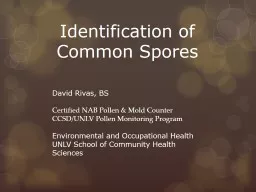

Asma Tahir MPH Certified NAB Pollen amp Mold Counter CCSDUNLV Pollen Monitoring Program Environmental and Occupational Health UNLV School of Community Health Sciences What is mold Mold is considered a subgroup of ID: 801036
Download The PPT/PDF document "Identification of Common Spores" is the property of its rightful owner. Permission is granted to download and print the materials on this web site for personal, non-commercial use only, and to display it on your personal computer provided you do not modify the materials and that you retain all copyright notices contained in the materials. By downloading content from our website, you accept the terms of this agreement.
Slide1
Identification of Common Spores
Asma
Tahir, MPH
Certified
NAB Pollen & Mold Counter
CCSD/UNLV Pollen Monitoring
Program
Environmental and Occupational Health
UNLV School of Community Health Sciences
Slide2What is mold?
Mold is considered a sub-group of
the Fungi
KingdomPresent on clothing, carpet, air we breathe, everywhereProduce spores that are extremely small and can be airborneDue to their light weight, mold spores are often floating in the air both outdoors and indoors
Slide3Mold Basics
Molds are a part of the natural environment
Breaks down organic matter
Mold should be avoided indoorsMold can grow on almost any surfaceWater or excessive moisture speeds up mold growth
Slide4Health Effects of Mold
Allergic reaction = by far the most common, inhalation of spores or touching
• Asthma = mold spores can trigger or make asthma worse
• Hypersensitivity pneumonitis = develop after acute or chronic exposure Runny nose, scratchy throat and sneezing. Most of us know this allergic illness as “hay fever” or “allergic rhinitis.
Slide5What's happening in your neighborhood?
Slide6Mold Around Us
Slide7Mold Around Us
Slide8Can You Eat Foods With Mold?
Moldy foods that people eat regularly
include:
some packaged fruit juices bleu cheese soy sauce stilton cheese
Slide9Mold Around Us
Slide10Just Add Water and They Grow
Slide11Common Indoor Molds
Slide12Alternaria
Name
Alternaria
conidia – “drumstick”Second most abundant component of dry air spora ShapeLarge multicellular spores
Septa are both beaked and produced in chains
Attachment scars visible at the tip of the beak
Various shades of brown
Size
7 µm X 18
μ
m to 15
μ
m
X 75
μ
m
Peak Concentrations
Late summer or fall
During afternoon hours with high wind gusts
Septa
Attachment Scar
Slide131000X
Slide14Ascospores
Sexual spores produced by ascomycete fungi
Vary enormously in size, shape, color and features
Shape Single-celled without any internal septa, two-celled with single septum, or multi-celled with many septaMulti-celled spores can be transverse or longitudinal Color ranges from colorless to dark brown and black spores
No attachment scar
Size
5
μ
m to over 100
μ
m
Peak Concentrations
Rainy periods but can be found during early morning hours or high humidity
Slide151000X
Slide16Basidiospores
Sexual Spores produced by
basidiomycetes
Mushrooms, bracket fungi, and puffballs Wide range in shape, size, and color ShapeALWAYS single-celled
Globose
, elliptical, fusiform,
nodulose
, angular, or irregular
Spore walls can be smooth or ornamented with spines, warts or ridges
Yellow, brown (various), or black in color
Size
Small; 5 to 12
μ
m
Peak Concentrations
Pre –dawn hours when humidity is high
Slide171000X
Slide18Cladosporium
Abundant airborne spores in temperate areas (90% of the U.S.)
Asexual fungi
ShapeEllipsoidal to cylindrical Pigmented with yellow to light brown Produced in chains , may be unicellular or have two septa
Prominent attachment scars
Size
Varies from 3
μ
m to 25
μ
m
Peak Concentrations
Detected year round in many areas
Highest levels from late spring to early fall
Slide19Slide20Smuts
Common Name
Black, dusty spores that are plant pathogens
1,200 species of smuts within 50 genera Shape Globose; with smooth, spinney, or reticulate walls Yellow to brown in color Size
3 to 24
μ
m
Peak Concentrations
Low humidity and gusty winds promote spore dispersal
Peak sunshine hours and high atmospheric pressure
Slide21Slide22Nearest Collection Sites
Joseph Neal Elementary School- 33 Miles
Palo Verde High School - 27 Miles
Slide23What is in your neighborhood
Slide24Current Sites
Total of
6
stations around the valley UNLV, Jean, 1 High School, 2 Middle Schools, and 1 Elementary School. Future sites in Henderson, Boulder City, and Southwest.
Slide25Questions?/Comments!